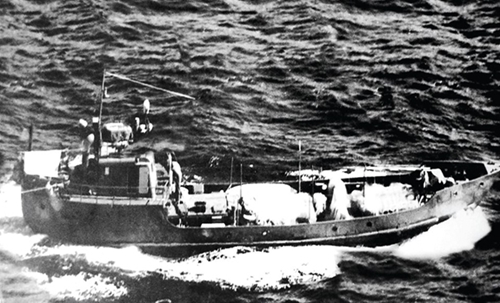After nearly one year of preparation, on October 11, 1962, the first motorized wooden boat of the group secretly leaving Wharf K15 in Do Son, Hai Phong City, carrying along 30 tons of weapon, arrived at Wharf Vam Lung in Ca Mau province safely. Since then, the Ho Chi Minh Trail at sea officially came into being.
Nearly 110,000 tons of weapons and equipment and 18,000 troops were transported to the Southern theater thanks to thousands of voyages through the trail during its 14 years of existence. Notably, many senior leaders of the Party, State and military were taken to Southern localities by boat, significantly contributing to the national struggle for independence and freedom. The Party and State have honored the Group with the ”Hero of the People’s Armed Force” title to recognize their great contribution.
    |
 |
|
No-number ships transported goods and equipment on the Ho Chi Minh Trail at sea. |
The Ho Chi Minh Trail at sea was bombarded severely by the enemy and the group had to regularly change transportation methods such as departing from and arriving at various docks, adjusting routes, and so on.
From 1961 to 1975, troops of Brigade 125 faced over 20 storms, escaped from hundreds of sieges of the enemy, and provided timely support for the Southern theater. Many among them sacrificed their lives to protect the secret of the trail.
The victories and experience from the operation of the Ho Chi Minh Trail at sea will be the pride of our people and troops in general and generations of troops of the Vietnam People’s Navy (VPN) in particular. They will last forever and be precious lessons for the national construction and defense cause in the current context.
At present, the task of firmly protecting the sovereignty of the sea, islands and territorial integrity of the Fatherland is posing new, very heavy and urgent requirements for the Vietnam People's Navy (VPN). To fulfill its role as the core force of the whole people's defense and the people's war at sea, the VPN should continue applying and promoting the spiritual values and lessons learned of the Ho Chi Minh Road at sea to build a revolutionary, regular, elite and modern VPN. At present, the VPN should focus on the implementation of the following key measures:
Firstly, the Naval Service should build firm units in term of political stance, contributing to improving their combined combat strength and fulfilling all assigned missions. They should strengthen the Party's absolute and direct leadership in every aspect, implement political and ideological education to help troops understand viewpoints and guidelines of the 13th National Party Congress, the 11th Military Party Congress as well as resolutions of the Party Central Committee and the Politburo. Their troops must be absolutely loyal to the Fatherland, the Party and the people; have strong will and high determination; and master modern weapons and equipment.
In particular, naval troops should be willing to sacrifice themselves to safeguard the national sovereignty over seas and islands.
Regarding the Party building, all naval units should promote the role of each Party organization, build strong and healthy Party organizations with high combat strength, and bring into play responsibility of Party members and commanders in guilding troops to undertake difficult tasks.
Secondly, the Naval Service should grasp all situations and promptly provide advice for the Party, State and the military on addressing issues emerging at sea. Due to the complicated situations in the East Sea (South China Sea) recently, the service needs to maintain high combat readiness, study to forecast all developments at sea, and avoid being put in a passive position in any circumstances. They should provide timely advice for the Party, the State the Central Military Commission, and the Ministry of National Defense on dealing with emerging situations at sea, accelerating combined strength, and defeating all schemes and plots of hostile forces. On the other hand, they should do their utmost to maintain a peaceful and stable environment at sea for developing economy, expanding cooperation, and boosting external relations with navies of other countries in the region and the world.
Thirdly, the Naval Service should promote the determination and creativeness in operating the Ho Chi Minh Trail at sea in the past to improving training and combat readiness at the moment, contributing to training a high-quality human resource for naval units. They should study precious lessons from Ho Chi Minh Trail at sea to apply to training missions, and building a regular and modern navy.
They should enhance the implementation of Resolution No.765-NQ/QUTW of the Central Military Commission and Resolution No.1050-NQ/DUQC of the Party Committee of the Naval Service on upholding training quality for the 2013-2020 period and the following years. Accordingly, the naval units should renew their leadership and training methods in order to firmly protecting the national sovereignty over sea and islands and building a regular, elite, and modern service.
Finally, the Naval Service should enhance building and developing a modern naval force in attachment with constructing the whole-people defense posture and the people warfare at sea. They need to follow the Party’s guideline and the State’s policies on building the military and the navy in the current context. Naval units should be equipped with modern weapons and equipment together with qualified forces. In addition, they should collaborate with localities to build a strong maritime militia and self-defense force as well as concrete plans to mobilize adequate forces for safeguarding the national sovereignty over seas and islands. They should back the fishermen in seafaring, protect maritime economy, and implement search and rescue missions.
Prior to the impacts of the fourth industrial revolution, the Naval Service should accelerate scientific research and master modern technologies, especially in maintaining weapons and equipment in the time to come.
Translated by Trung Thanh